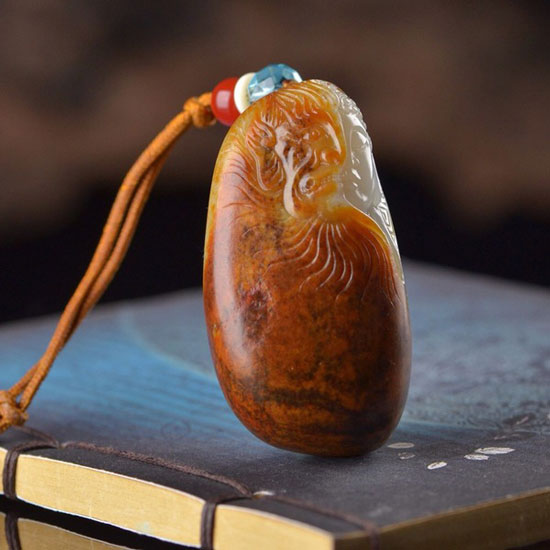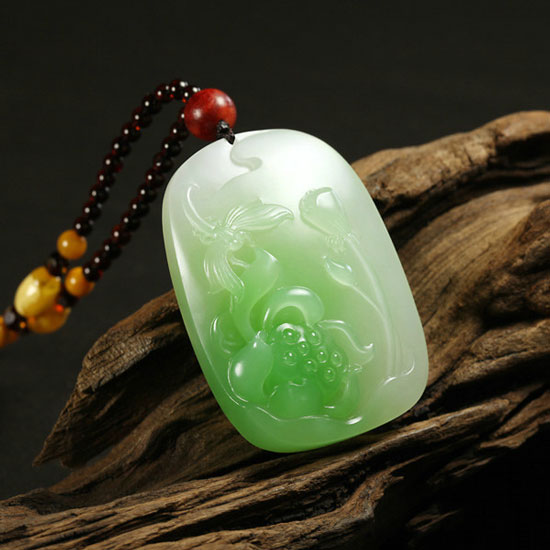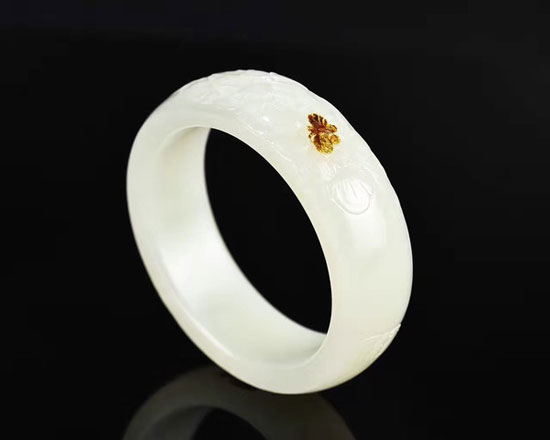The history of jade in our country can be described as far-reaching. As early as the late Paleolithic period nearly 10,000 years ago, the Chinese ancestors discovered and began to use jade. It is generally believed that people in ancient times discovered jade minerals when making and using stone tools. Because it is harder than ordinary stones, it is used to process other stone products. At the same time, it has a distinctive color and brilliance, crystal clear and fascinating, so people slowly use it to make decorations. Because the number of jade is not many and the processing is difficult, only a few heads in the ethnic group, such as the patriarch and the priest, are qualified to wear and use it, which gradually evolved into a ritual, ritual or totem. It is in this long and slow evolution that jade is transformed from a stone of a special nature into a symbol of power, status, wealth, and theocracy. Just like in the late Neolithic period from about 7,000 to 4,000 years ago, the sacred priests used the precious jade to make "the rituals" and worship God's ancestors. They believe in the heavens and the earth, and they will round up the dragons and the squares to worship the gods and the earth. They believe that the life of the clan's distant ancestors is derived from God through the gods, and they are carved on the jade to depict the ancestors of God. Even carving a very deep symbol to worship. I hope to use the unique texture, shape, pattern and symbols of jade, to generate the magic of induction, to communicate with God's ancestors, to draw their wisdom, and to obtain fortune. In the ancient society, the personal status was high, and the relationship between the person and the ancestors of God was determined. The "rites" of the gods establish a communication channel between the gods and the gods, and also maintain the harmonious relationship between people. "Rui" is a jade symbolizing status. The systems of "sacrificial devices" and "Ruiqi" originated in the late Neolithic period, and the summer, merchants, and Zhou Dynasty continued to develop in line with different political systems and social structures. In the Zongmiao Festival and the Asahi Association, the metaphysical function is played to maintain the ritual system, so it is always called "the ritual." The earliest real jade articles in China were unearthed from the 7th and 8th millenniums ago, the Inner Mongolia Aohan Banner Xinglongtun Site in the middle and late Neolithic Age, the Liaoning Fuxin Chahai Site, the Shenyang Xinle Site and the Zhejiang Hemudu Site. The cultural, religious and political attributes of jade have gradually improved in Xia, Shang and Zhou. In the Eastern Zhou Dynasty, humanism rose, and Confucianism inherited some of the cultural components of the original religion, moralized and lived, and advocated the concept of "the gentleman is better than the jade". Therefore, the wind of Pei Yu is so grand, and the carving is exquisite, and later generations are hard to come by. The Han Dynasty Chongyu, the survivor of the jade, the jade; the dead wrapped in jade, filled with jade. Even on the enamel paintings and tomb bricks, they are decorated with jade images. The round ç’§ helps the soul to pass the heavens, and at this time it is extremely useful. From the Six Dynasties to the Tang Dynasty, the art of jade carving in the Middle Kingdom turned down. Although Li Tang Sheng Shi, still adhering to the Taoist system, holding the Zen ceremony, but the book of the gods and gods are difficult to use the real jade, and replaced by the second jade. Handed down jade articles, only see 銙, comb, ç°ª, 佩, etc. Some are also made by Western artisans. The Song and Ming dynasties descended, the jade carving art flourished again, and the emperor ceremonies used jade. Moreover, due to the scholars' examination of the Shang and Zhou ritual systems, the folk shackles raised the upsurge of research and imitation of ancient jade. At this time, the class of scholars combined with knowledge pays attention to the quality of life. The jade-style textbooks are furnished with practical functions in addition to appreciation and play. The flowers, birds, figures, landscapes, etc. in nature have also become decorative themes, presenting a soft and elegant literati taste. Because of the jade materials taken, most of them are river jade, and jade workers often use their skills. The finished product is often intentional and will be peaceful. Confucius said that jade has eleven virtues such as benevolence, wisdom, righteousness, and ritual. The book of "Book of Rites" says that "the gentleman has no reason, and jade does not go to the body", all emphasize that people with social status and status should learn from jade and warn them. There is no special reason, so jade does not leave. The Chinese nation's sentiments of worshipping jade, respecting jade, and loving jade were inferior to those of the Han and Tang Dynasties in the Ming and Qing Dynasties. Jade's elegance and holiness conquered generations of Chinese. Zunyu, Aiyu, Peiyu, Yuyu, jade, and jade are the true portrayals of jade lovers in society. From the old three generations from Qin Han to Sui and Tang Dynasties, jade articles have always been the exclusive decorative items of the royal family. During the two Song Dynasty, the economy was developed and the business was prosperous. Due to the advancement of handicraft technology, jade processing became more convenient and fast, and the jade and jade winds were flourishing. At this time, there were a large number of jade ornaments and jade pieces that were exquisitely crafted, delicately processed, and wonderfully conceived. In the Ming and Qing Dynasties, the jade making and playing rewards reached its peak, and the variety was more colorful. It was as small as Yutou, jade button, and the whole piece of Yupingfeng, Yushan and Yushu. The royal family also used jade to make Japanese utensils such as jade bowls, jade cups, jade pots and so on. In general, the jade is made of white jade (especially the white jade white jade produced in Xinjiang), followed by topaz, jade again, and jade (such as southern jade, Henan jade). At the beginning of the Qing Dynasty, jade was introduced into the Central Plains, and its touching greenery immediately won the hearts of the Chinese people. The jade ornaments made of jade are popular and become the fashion that people are competing for. But in the eyes of the traditional Chinese, jade ornaments made of jade are far less than ancient jade. In terms of mineralogy, jade can be divided into two types, one is the hornblende group in the bond silicate, including tremolite and actinolite, also known as nephrite. There is also a single-chain silicate alkaline clinopyroxene, also known as jadeite (such as jadeite). Most of the traditional Chinese jade is nephrite, including Xinjiang jade, jade jade, etc., but in the early Qing Dynasty, Wu Sangui pursued the emperor of Nanming Yongli to enter and control the mining area rich in jade in Yunnan and northern Myanmar. It’s popular. Today, we see that most of the ancient jade in prehistoric times are jade tools such as jade knives, jade axes, and jade needles. Then there will be jade rituals (sacrificial instruments) such as the jade and trigeminal ornaments of Liangzhu culture, and some jade ornaments such as the jade dragons and jade pigs of Hongshan culture should be made as the totem of the ethnic group. The jade of this period is not entirely made of jade, which is referred to by modern meaning. It can be jade or just a beautiful stone, such as the tremolite ore that is symbiotic with the metamorphic marble. In the late Neolithic period to the Bronze Age, it was no longer difficult to see jade tools in the mainstream cultural areas of China. Instead, there were a large number of jade and jade accessories such as jade dragons and jade unearthed from the Shang Dynasty Women’s Tomb. Wind, jade crane. At this time, nephrite has been widely used to make utensils. In the eyes of ordinary people, jade is a stone. The jade in the eyes of the Chinese is different. It has transcended the category of simple taxonomy and has become the spiritual sustenance of the Chinese nationality. Until today, if we pick up an emerald, we will only evaluate its color, its texture, and its production. But when we see an ancient jade, when we appreciate its shape, its twilight, its material, the heart will rise but it will be a strong national pride. The reason is because the ancient jade Pregnancy contains the precipitation of the five thousand years of Chinese civilization and the national spirit of the descendants of the Yellow Emperor. Ponti Roma Fabric,Ponte Roma Knit,Ponti Roma Dobby Fabric,Ponti Roma Rayon Nylon Spandex Shaoxing Sinofashion Textiles Co.,Ltd. , https://www.shownaturetex.com

